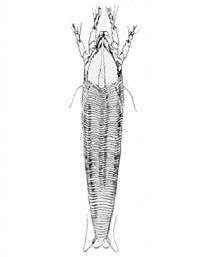Abacarus hystrix
Abacarus hystrix, the cereal rust mite or grain rust mite, belongs to the family Eriophyidae. They are extremely small with adults measuring up to one millimeter in length and only have four legs at the front of the body. Viewing by the human eye requires, a 10 – 20X lens.[1] The adult mites are usually yellow but also have been seen to be white or orange. The cereal rust mite was first found on Elymus repens (couch grass), a very common perennial grass species. It has now been found on more than 60 grass species including oats, barley, wheat and ryegrass, found in Europe, North America, South Africa and Australia.[2][3] Mites migrate primarily through wind movement and are usually found on the highest basal sections of the top two leaf blades.[3] Abacarus hystrix produces up to twenty overlapping generations per year in South Australian perennial pastures, indicating that the species breeds quite rapidly.[4] It has been noted that the cereal rust mite can cause losses in yield of up to 30-70%.[5]
| Cereal rust mite | |
|---|---|
 | |
| Abacarus hystrix (Cereal rust mite) | |
| Scientific classification | |
| Kingdom: | Animalia |
| Phylum: | Arthropoda |
| Subphylum: | Chelicerata |
| Class: | Arachnida |
| Subclass: | Acari |
| Order: | Trombidiformes |
| Family: | Eriophyidae |
| Genus: | Abacarus |
| Species: | A. hystrix |
| Binomial name | |
| Abacarus hystrix Nalepa, 1896 | |
Life cycle
Cereal rust mite eggs are exceptionally small and are placed in leaf vein grooves by the mite.[1] The eggs usually begin hatching at the beginning of spring (March in the Northern Hemisphere and September in the Southern Hemisphere) and once they have reached the juvenile stage, the mites mature very quickly (16–18 days). Once the mites are at the adult stage they often travel to the lower section of the plant where they feed on young tissues.[1] Mites are always present for the full growing season of the plant, but activity has been seen to decrease as the temperature begins to rise, this is because unlike other mite species the cereal rust mite favors much cooler temperatures.[1]
Impacts of mite on grasses
Abacarus hystrix is a vector for two viruses (Agropyron mosaic and Ryegrass mosaic) and also causes direct damage to the leaf.[3] The effect of the Ryegrass Mosaic Virus (RMV) which is only transmitted by this mite, is chlorotic streaks on the leaves.[6][7] When the mite feeds on grooves of the leaf surface, it prefers the large cells on the smooth bottom of the groove as opposed to the more ridged, small cells of the side walls.[3] Mite feeding causes direct damage to the leaves, which can be noticed as discoloration or “rusting” of the leaf.[8]
Eradication and management options
As a precaution, fields should be checked regularly for mites before spring. By the use of a quadrat system, random plants are selected from different locations in the field. When checking, look for eggs and juvenile mites in the specific area of the leaf veins.[1] A potential management option is to reduce the length of the grass in the cooler months. Studies have shown that trimming grasses reduces the number of mites and since the mites are vectors of many viruses, these viruses are spread less quickly.[1][9][3]
References
- Whalen, J. and Cissel, B. 2012. Cereal Rust Mite in Timothy. Available at: "Archived copy". Archived from the original on 2013-10-31. Retrieved 2013-10-30.CS1 maint: archived copy as title (link) Accessed 23 Oct 2013]
- Skoracka, A. 2008. Quackgrass- and ryegrass-adapted populations of the cereal rust mite, Abacarus hystrix (Acari: Eriophyidae), differ in their potential for wheat, Triticum aestivum, colonization. Bulletin of Entomological Research, 99 pp. 33-39.
- Gibson, R. 1974. Studies on the feeding behaviour of the eriophyid mite Abacarus hystrix, a vector of grass viruses. Annals of Applied Biology, 78 (3), pp. 213-217. [Accessed: 28 Oct 2013].
- Frost, W. 1997. Polyphenic wax production in Abacarus hystrix (Acari: Eriophyidae), and impfications for migratory fitness. Physiological Entomology, 22 pp. 37 - 46.
- Fleming, R. 1980. The potential for control of cereal rust by natural enemies. Theoretical Population Biology, 18 (3), pp. 375 - 395.
- Mulligan, T. 1960. The Transmission by Mites, Host-Range and Properties of Ryegrass Mosaic Virus. Annals of Applied Biology, 48 (3), pp. 575 - 579.
- Skoracka, A. 2008. Reproductive barriers between populations of the cereal rust mite Abacarus hystrix confirm their host specialization. Evolutionary Ecology, 22 (5), pp. 607 - 616.
- Skoracka, A. 2009. Description of Abacarus lolii n. sp. (Prostigmata: Eriophyoidea: Eriophyidae), a cryptic species within a grass–feeding Abacarus complex. International Journal of Acarology, 35 (5), pp. 405-416.
- Gibson, R. 1976. Effects of Cutting Height on the Abundance of the Eriophyid Mite Abacarus hystrix (Nalepa) and the Incidence of Ryegrass Mosaic Virus in Ryegrass. Plant Pathology, 25 (3), pp. 152 - 156.